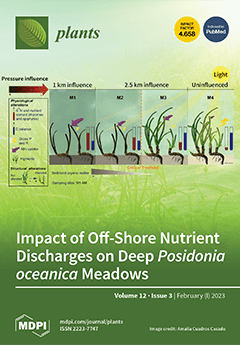Wheat is a target crop within the food security context. The responses of wheat plants under elevated concentrations of CO
2 (
e[CO
2]) have been previously studied; however, few of these studies have evaluated several organs at different phenological stages simultaneously under free-air CO
2 enrichment (FACE) conditions. The main objective of this study was to evaluate the effect of
e[CO
2] in two cultivars of wheat (Triumph and Norin), analyzed at three phenological stages (elongation, anthesis, and maturation) and in different organs at each stage, under FACE conditions. Agronomic, biomass, physiological, and carbon (C) and nitrogen (N) dynamics were examined in both ambient CO
2 (
a[CO
2]) fixed at 415 µmol mol
−1 CO
2 and
e[CO
2] at 550 µmol mol
−1 CO
2. We found minimal effect of
e[CO
2] compared to
a[CO
2] on agronomic and biomass parameters. Also, while exposure to 550 µmol mol
−1 CO
2 increased the photosynthetic rate of CO
2 assimilation (An), the current study showed a diminishment in the maximum carboxylation (
Vc,max) and maximum electron transport (
Jmax) under
e[CO
2] conditions compared to
a[CO
2] at physiological level in both cultivars. However, even if no significant differences were detected between cultivars on photosynthetic machinery, differential responses between cultivars were detected in C and N dynamics at
e[CO
2]. Triumph showed starch accumulation in most organs during anthesis and maturation, but a decline in N content was observed. Contrastingly, in Norin, a decrease in starch content during the three stages and an increase in N content was observed. The amino acid content decreased in grain and shells at maturation in both cultivars, which might indicate a minimal translocation from source to sink organs. These results suggest a greater acclimation to
e[CO
2] enrichment in Triumph than Norin, because both the elongation stage and
e[CO
2] modified the source–sink relationship. According to the differences between cultivars, future studies should be performed to test genetic variation under FACE technology and explore the potential of cultivars to cope with projected climate scenarios.
Full article






